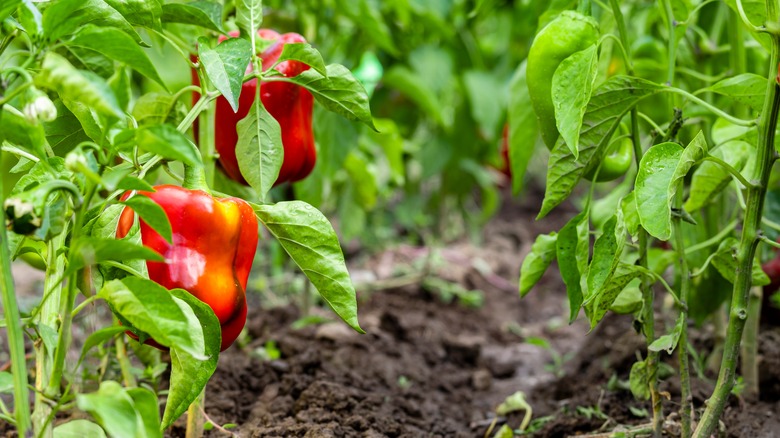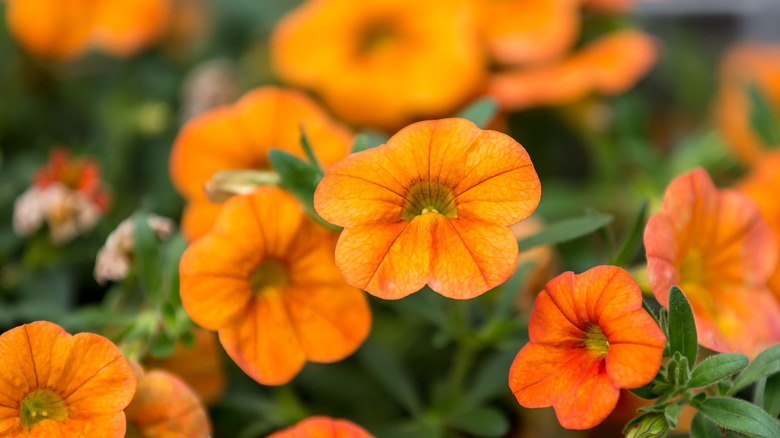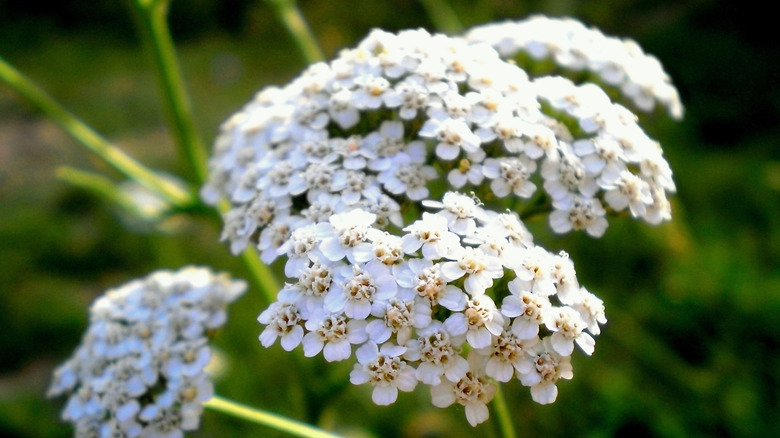Companion Plants That Will Thrive Next To Your Peppers In The Garden
Hot peppers, sweet peppers, and all the peppers in between are considered easy to grow and relatively low-maintenance. Yet, like most other vegetable or fruit plants, they are threatened by things such as pests, disease, cold weather, and wet feet. Anything that you can do to make your pepper plants grow quicker, more healthily, or produce a larger yield should not be ignored. One of the easiest ways to ensure you are doing right by your peppers is to pair them with a companion plant. Peppers can make lots of friends in the garden, and many people are shocked to learn the number of herbs and flowers as well as fruit and vegetable plants that are ready to lend a helping hand to these spicy fruits.
Whether you are looking to fill a bed with everything you need to make a delicious salsa garden or you want to add some easy-to-maintain ornamental peppers to your native flower garden, there is a partner that will help your Capsicum species succeed. Lots of commonly grown garden plants, such as tomatoes, oregano, radishes, marigolds, beans, and more, will repel harmful insects, attract pollinators, fix the soil, or simply cohabitate without causing any problems. It's up to you to choose the right neighbor for your peppers. Keep reading and we'll give you a head start on this match-making journey.
1. Peppers
Among the most obvious companions for pepper plants (Capsicum annuum) are other peppers. Just about every type of pepper plant is a part of the Capsicum genus, and most are a cultivar or variety of the annuum, frutescens, or chinense species. Bell peppers, ornamental peppers, peperoncini, cayenne peppers, Thai peppers, and more all belong to the same species, which makes them simple to grow in one large garden bed.
Bloom Season: Summer
USDA Growing Zone: 4 to 11
Growing Conditions: Full sun
Soil Type: Rich, moist, and well-draining
Size: 1 to 4 feet tall and 1 foot wide
2. Onion
When dealing with pests attacking your peppers, consider companion planting with smellier crops, like onions (Allium cepa). Onions are known to repel a variety of harmful insects, such as green peach aphids, slugs, and cabbage worms, that transmit viruses and feast on the plants' tender foliage. Even better, if the onions succeed in protecting your peppers, you can make a delicious pico de gallo come harvest time.
Bloom Season: Spring and summer
USDA Growing Zone: 4 to 9
Growing Conditions: Full sun
Soil Type: Organic and well-draining
Size: 1 to 3 feet tall and 1 to 2 feet wide
3. Carrots
Carrots (Daucus carota var. sativus) are good companion plants for peppers due to their low-growing habit and simple care needs. In fact, root vegetables are often planted alongside peppers in hopes that they will loosen the soil below. What we're certain of, however, is that the two companion plants help each other grow. The carrots' foliage provides shade for the peppers' roots, and the peppers create sun protection for the carrot tops.
Bloom Season: Summer
USDA Growing Zone: 2 to 11
Growing Conditions: Full sun
Soil Type: Fertile and well-draining
Size: Up to 3 feet tall and wide
4. Subterranean clover
Subterranean clover (Trifolium subterraneum) is another friend to pepper plants who need their roots kept cool. The low-growing clover species acts as a living mulch below the peppers and shades the soil while also acting as a weed suppressant. But, that's not all. As a close relative of beans, subterranean clover can fix the nitrogen in the soil, which helps pepper plants grow larger, faster, and more healthily.
Bloom Season: Spring
USDA Growing Zone: 7 to 11
Growing Conditions: Full sun to partial shade
Soil Type: Well-draining
Size: up to 1 foot tall and 3 feet tall
5. Cilantro
Several herbs get along with peppers, including cilantro (Coriandrum sativum). Cilantro is a plant that has very few problems in the garden. Due to its bold scent, most insects are driven away from the herb, but conveniently, it won't repel beneficial bugs like butterflies. Planting peppers, cilantro, onions, and even tomatoes near each other can yield more fruit, and they'll provide most of what you need for a killer taco night.
Bloom Season: Summer
USDA Growing Zone: 2 to 11
Growing Conditions: Full sun to partial shade
Soil Type: Well-draining
Size: 1 to 2 feet tall and wide
6. Parsley
Parsley (Petroselinum crispum), which is a member of the carrot family, can grow beside peppers too. The pair have similar growing requirements. They both need direct sunlight, warm summer temperatures, and rich, well-draining soil to thrive. Like cilantro, the parsley plant's fragrant leaves can also bring out beneficial bugs that snack on pests, such as hoverflies and parasitoid wasps.
Bloom Season: Summer
USDA Growing Zone: 3 to 9
Growing Conditions: Full sun
Soil Type: Rich and well-draining
Size: 12 to 18 inches tall
7. Sunflowers
Planting sunflowers (Helianthus annuus) next to your peppers can be very beneficial as the time to harvest approaches. While sunflowers won't help the sometimes-spicy plants directly, they will attract pollinators from far and wide to your garden. In doing so, insects such as bees, butterflies, and birds can pollinate their flowers and provide you with more juicy peppers.
Bloom Season: Summer to fall
USDA Growing Zone: 2 to 11
Growing Conditions: Full sun
Soil Type: Rich, loose, and well-draining
Size: 5 to 10 feet tall and 2 feet wide
8. Basil
The basil plant (Ocimum basilicum) is thought to aid in pepper production to bring forth a larger yield of tasty peppers. For now, this is an ill-researched claim, but it's worth a shot, especially because basil has more than one benefit when grown nearby plants in the Capsicum genus. The herb helps deter thrips that mangle pepper plants' leaves and buds.
Bloom Season: Summer to fall
USDA Growing Zone: 2 to 11
Growing Conditions: Full sun
Soil Type: Rich and well-draining
Size: 2 feet tall and wide
9. Garlic
Garlic (Allium sativum), which grows very similarly to onions, can be neighbors with pepper plants that will benefit from the Allium species' ability to repel hungry pests. Be sure to keep your garlic plants in full sun and well-draining soil. They tend to thrive in the same sort of environment as peppers due to their history of growing in hotter climates. Unfortunately, the pepper plants can't offer much protection to garlic plants in return.
Bloom Season: Spring
USDA Growing Zone: 7 to 10
Growing Conditions: Full sun
Soil Type: Organic and well-draining
Size: Up to 3 feet tall
10. Sweet alyssum
Sweet alyssum (Lobularia maritima) solves a couple of issues when planted under pepper plants. Like clover, it acts as a living mulch that keeps the soil moist and cool for the peppers' roots. And, like sunflowers, sweet alyssum's small flowers attract pollinators and insects that help both plants. Not to mention, the clusters of white, red, pink, or purple blooms release a nice fragrance, making your peppers even more ornamental.
Bloom Season: Spring to fall
USDA Growing Zone: 5 to 9
Growing Conditions: Full sun to partial shade
Soil Type: Well-draining
Size: 3 to 9 inches tall
11. Nasturtium
Nasturtium (Tropaeolum spp.) is constantly cited as a companion plant for a variety of species. Grown next to popular fruit and vegetable-producing plants, the orange flower uses its peppery scent to ward off pests. Even though nasturtium is a warm-weather annual, it does self-sow quite easily and comes back year after year to keep harmful insects away from your precious pepper plants.
Bloom Season: Spring to fall
USDA Growing Zone: 2 to 11
Growing Conditions: Full sun
Soil Type: Well-draining
Size: 1 to 10 feet tall and 1 to 3 feet wide
12. Radishes
Radishes (Raphanus sativus) are another root vegetable that are valuable to grow with your pepper plants. Though the peppers aren't likely to make your radishes any larger or tastier, radishes can loosen the soil for peppers before they fully mature. Breaking up the soil helps the roots of pepper plants reach more nutrients and moisture. As a bonus, radishes can be used as a trap plant for flea beetles, who often kill young pepper plants.
Bloom Season: Spring
USDA Growing Zone: 2 to 11
Growing Conditions: Full sun
Soil Type: Well-draining
Size: 2 to 3 feet tall
13. Tomatoes
Tomatoes (Solanum lycopersicum) grow well together with peppers as they require many of the same growing conditions. Pairing them together makes harvesting easier, and you could make a delicious salsa out of the two. Keep in mind, however, that tomato plants will become quite large. If they are too close to your peppers, they will cast shade, which can lead to stunted growth, disease, and infestations of harmful insects.
Bloom Season: Summer
USDA Growing Zone: 10 to 11
Growing Conditions: Full sun
Soil Type: Fertile, moist, and well-draining
Size: Up to 6 feet tall and 3 feet wide
14. Marigolds
If you are fond of growing nasturtium flowers to control pests in your garden, you'll likely love marigolds (Tagetes patula) just as much. Marigolds' thick orange-yellow flowers are great at keeping insects away from a vegetable patch and bringing in pollinators to increase your yield. Not only does this flower repel above-ground pests like mosquitos, aphids, and whiteflies, but it also scares away soil nematodes with its roots.
Bloom Season: Spring to fall
USDA Growing Zone: 2 to 11
Growing Conditions: Full sun to partial shade
Soil Type: Moist and well-draining
Size: 1 foot tall and wide
15. Chives
If you prefer to avoid planting onions or garlic in your garden, chives (Allium schoenoprasum) might be a good alternative. A member of the same genus, chives have the same pungent smell that deters aphids and a handful of other pests. However, the skinny stalks typically used to garnish soups and meat dishes are often easier to grow and much less work to maintain compared to similar plants.
Bloom Season: Summer
USDA Growing Zone: 4 to 8
Growing Conditions: Full sun to partial shade
Soil Type: Evenly moist and well-draining
Size: 1 to 2 feet tall
16. Coneflowers
Though most of them won't deter bad bugs, native flowers such as the purple coneflower (Echinacea purpurea) can be helpful in vegetable gardens as they attract local pollinator species and deter wildlife, such as deer, from browsing. Coneflowers are tolerant of heat, drought, and less-than-fertile soil, which makes them a good companion plant for peppers that are heavy-feeders with a preference for warm weather conditions.
Bloom Season: Mid-summer to late fall
USDA Growing Zone: 3 to 9
Growing Conditions: Full sun to partial shade
Soil Type: Evenly moist and well-draining
Size: 4 feet tall and 2 feet wide
17. Eggplant
A member of the Solanaceae family, eggplants (Solanum melongena) are well-suited to growing alongside peppers. They share many of the same needs such as direct sunlight, warm temperatures, and well-draining soil. Be careful that you don't plant them too close together. Eggplant plants grow larger than pepper plants, and they may easily shade the peppers. This would lead to poor growth, unsatisfactory fruit production, and lowered disease resistance.
Bloom Season: Summer
USDA Growing Zone: 9 to 12
Growing Conditions: Full sun
Soil Type: Fertile, moist, and well-draining
Size: 2 to 4 feet tall and 1 to 3 feet wide
18. Wild geraniums
Wild geraniums (Geranium maculatum) are plants with light purple flowers that are native to the Eastern United States. They can be found growing in woodlands where they thrive in the shade without human intervention. However, geraniums can be placed in full sun as long as their soil is plenty moist. Here, they will produce more blooms and help deter Japanese beetles, which are a frequent pest of pepper plants.
Bloom Season: Spring
USDA Growing Zone: 3 to 8
Growing Conditions: Full sun to shade
Soil Type: Moist and well-draining
Size: 1 to 2 feet tall
19. White clover
White clover (Trifoleum repens) is among the most recognizable clover species. It produces green trifoliate leaves and globular white flowers that typically reach only a few inches from the ground. Its low growth habit makes it a good option as a living mulch under a pepper plant's canopy. While the peppers provide a bit of shade for the clover, the clover keeps the pepper's feet cool.
Bloom Season: Spring and summer
USDA Growing Zone: 3 to 10
Growing Conditions: Full sun to partial shade
Soil Type: Moist and well-draining
Size: 6 inches tall and 1 foot wide
20. Spinach
Spinach plants (Spinacia oleracea) are another option for planting below your peppers as a living mulch. Like plants in the Capsicum genus, spinach enjoys rich and evenly moist soil that isn't too wet. Yet, unlike peppers, it can withstand a bit of shade, especially during hot summer days. Planted beneath taller pepper plants, spinach makes use of the cooling shade while also acting as cover for the peppers' roots.
Bloom Season: Summer
USDA Growing Zone: 2 to 11
Growing Conditions: Full sun to partial shade
Soil type: Rich and well-draining
Size: 6 to 12 inches tall and wide
21. Oregano
Oregano (Origanum vulgare) is yet another herb with pest-repellent properties that pepper plants can benefit from. The edible plant won't compete for space with the peppers, and it shouldn't grow tall enough to cast any shade on them either. In the summer, oregano plants will bloom with small purple flowers that are attractive to hummingbirds, butterflies, and other pollinators.
Bloom Season: Summer
USDA Growing Zone: 3 to 9
Growing Conditions: Full to partial sun
Soil Type: Well-draining
Size: 2 feet tall and wide
22. Beets
Beets (Beta vulgaris) are known for their deep red edible roots that can be eaten raw, steamed, boiled, sauteed, or pickled. Grown near pepper plants, beets' large leaves help keep the soil below cool and moist. When the pair is grown together as companion plants, you won't notice too many benefits, but they can keep each other in good health as they trade a bit of shade.
USDA Growing Zone: 2 to 11
Growing Conditions: Full sun to light shade
Soil Type: Moist, organically-rich, fertile, and well-draining
Size: 1 to 2 feet tall and wide
23. Black-eyed peas
The black-eyed pea plant (Vigna unguiculata) is a vining legume that helps fix nitrogen in the soil using nodules on its roots. This is beneficial for nearby pepper plants, especially those growing in nutrient-deficient soil. The widely spreading bean plant also has a long taproot that can quickly grow several feet long. Its tight hold on the ground makes it possible for the plant to prevent erosion and weed growth nearby.
Bloom Season: Summer
USDA Growing Zone: 10 to 11
Growing Conditions: Full sun to partial shade
Soil Type: Sandy and well-draining
Size: Up to 16 feet long
24. Marjoram
Marjoram (Origanum majorana) is a warm-weather plant that rarely grows outside zones 9 to 11 as anything other than an annual. Similarly to peppers, marjoram enjoys full sun and well-draining soil, but it doesn't need as much moisture to survive. It prefers drier soil that is gritty because it is susceptible to root rot. If you're careful not to overwater marjoram, it will deter some insects and never compete for nutrients or growing space.
Bloom Season: Summer
USDA Growing Zone: 9 to 11
Growing Conditions: Full sun
Soil Type: Well-draining
Size: 1 to 2 feet tall and wide
25. Rosemary
Rosemary (Salvia rosmarinus) is a tall-growing herb that produces fragrant leaves for culinary use, as well as pretty purple-blue flowers that appear in the spring and summer months. Planted alongside pepper plants, rosemary bushes keep leaf-sucking aphids at bay that threaten the spicy fruits. Be careful that your rosemary shrubs don't overrun your peppers; you may have to be diligent about pruning them back if they adopt vigorous growth patterns in your garden.
Bloom Season: Spring and summer
USDA Growing Zone: 8 to 10
Growing Conditions: Full sun
Soil Type: Well-draining
Size: 8 feet tall and wide
26. Petunias
Petunias (Petunia spp.) are a particularly welcome flower for planting near peppers. Because they are extremely low-maintenance, you can focus on nurturing your Capsicum plants. Their brightly colored blooms, which have a delightful scent, will also help you keep your peppers healthy by attracting a range of pollinator species to the area.
Bloom Season: Spring
USDA Growing Zone: 10 to 11
Growing Conditions: Full sun
Soil Type: Well-draining
Size: 6 to 15 inches tall, depending on the cultivar
27. Yarrow
Yarrow (Achillea spp.) is another flowering plant that can help pepper plants in a few different ways. As you likely already know, the clusters of small blossoms borne on yarrow stems bring pollinators and other beneficial bugs to your peppers. Specifically, these summer-blooming flowers attract aphid-eating ladybugs that are a valuable asset to any edible garden.
Bloom Season: Summer to early fall
USDA Growing Zone: 4 to 8
Growing Conditions: Full sun to partial shade
Soil Type: Nutrient-poor and dry
Size: 2 to 3 feet tall and 1 foot wide
28. Dill
While dill (Anethum graveolens) is great for making homemade pickles or a delicious tzatziki sauce, it is also a wonderful trap plant, pollinator-attractor, and larval host plant. While your dill grows tall and spreads out, it pulls attention away from your peppers and brings the insects to its own leaves and flowers. They, in turn, distract harmful pests to allow your peppers to grow properly and bring in beneficial bugs to eat pests and pollinate your peppers.
Bloom Season: Summer
USDA Growing Zone: 2 to 11
Growing Conditions: Full sun
Soil Type: Well-draining
Size: 1 to 4 feet tall




























